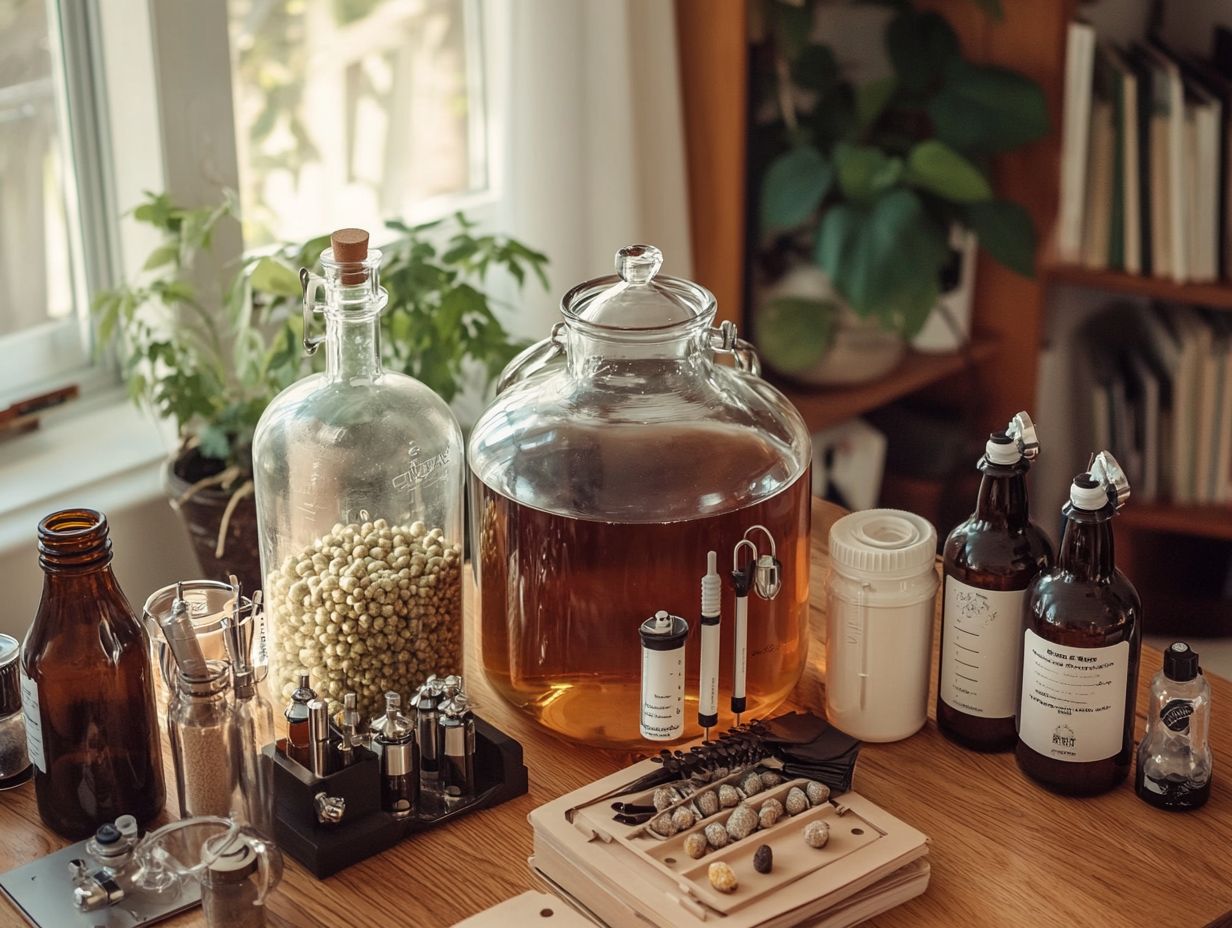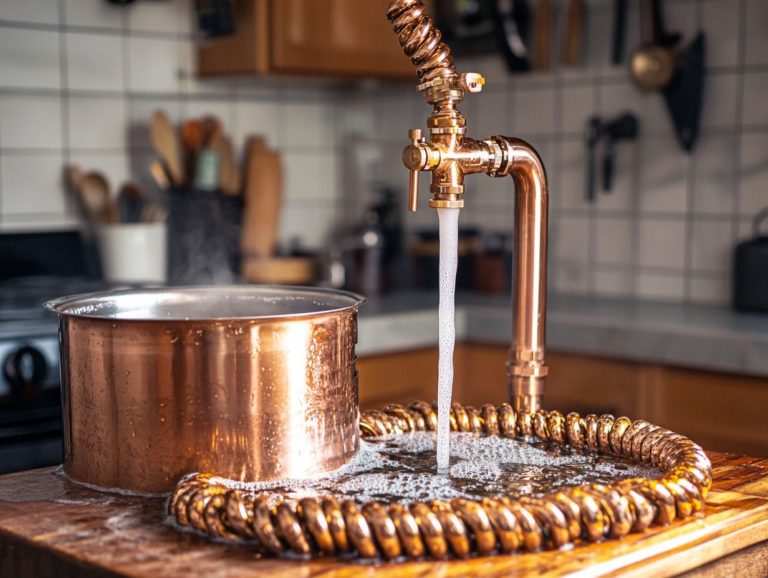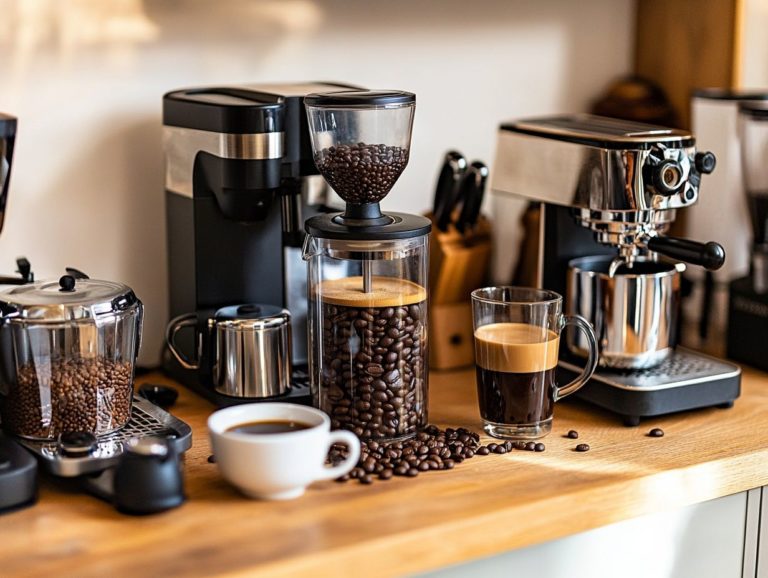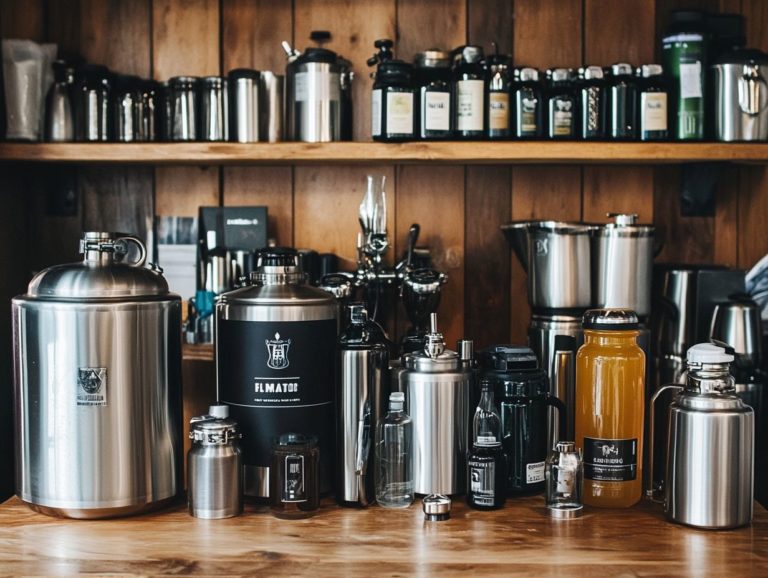The Best Home Brewing Equipment for Beginners
Home brewing stands as a rewarding endeavor, offering you the chance to craft your own unique beer right in the comfort of your home. Get ready to brew your first batch and impress your friends with your homemade beer!
Whether you find yourself as a complete novice or seeking to refine your brewing skills, having the right equipment is key to ensuring a successful brewing experience.
This guide delves into the ten essential tools that every beginner should have, ranging from basic kits to fermentation vessels. Additionally, it highlights the myriad benefits of brewing at home, provides tips for selecting the right gear, and outlines common pitfalls to avoid.
Prepare to embark on your exciting brewing adventure!
Contents
- Key Takeaways:
- 1. Basic Brewing Kit
- 2. Fermentation Vessel
- 3. Bottling Equipment
- 4. Hydrometer
- 5. Thermometer
- 6. Auto-Siphon
- 7. Bottle Capper
- 8. Sanitizer
- 9. Brew Kettle
- 10. Wort Chiller
- What Is Home Brewing and Why Should You Try It?
- Frequently Asked Questions
- What factors should I consider when choosing the best home brewing equipment?
- What equipment do I need to start homebrewing?
- Is a homebrew kit necessary for beginners?
- What is the best type of brewing equipment for beginners?
- How much should I expect to spend on homebrew equipment?
- Can I use any type of pot or fermenter for homebrewing?
Key Takeaways:

- Invest in a basic brewing kit, fermentation vessel, bottling equipment, and hydrometer for a successful start to home brewing.
- Sanitize all equipment to prevent contamination and invest in a wort chiller to cool down the liquid quickly.
- Choose the right equipment and follow the essential steps of the home brewing process to avoid common mistakes and achieve a successful brew.
1. Basic Brewing Kit
A basic brewing kit is an essential companion for anyone stepping into the world of homebrewing, equipping you with the tools needed to craft delicious beer right from the comfort of your home. This kit typically includes all the critical components, such as a fermentation bucket, quality yeast, and other necessary ingredients that simplify the brewing process.
It s perfect for beginners eager to explore extract brewing methods or venture into the exciting realm of all-grain brewing.
These brewing kits often feature top-notch equipment from reputable manufacturers like Northern Brewer and Craft-A-Brew, ensuring you have the reliable tools required for your craft. Take the fermentation bucket, for example; it serves as the heart of the brewing process, helping turn sugars into alcohol while preventing any pesky contamination.
The inclusion of a hydrometer is also vital, allowing you to measure specific gravity and monitor fermentation progress with precision. The quality ingredients, including hops and malt extracts, are thoughtfully curated to elevate flavor profiles, making each batch a unique and rewarding experience.
With every component designed with intention, these kits provide the perfect introduction to homebrewing, enabling you to create your own brews with confidence and flair.
2. Fermentation Vessel
The fermentation vessel is essential in your brewing journey, serving as the magical space where wort transforms into beer through the amazing work of yeast.
You have a variety of fermentation vessels at your disposal, such as plastic buckets, glass carboys, and stainless steel fermenters, each with unique characteristics that can influence both fermentation temperature and the final style of your beer.
For instance, glass carboys offer superior temperature control and act as a solid barrier against oxygen, making them ideal for delicate or hop-forward styles. Conversely, plastic buckets are lightweight and easy to maneuver, though they may not provide the same level of insulation.
It’s crucial to maintain rigorous sanitation practices. Any contaminants can wreak havoc on fermentation, leading to off-flavors and disappointing results in your final product.
By adhering to proper cleaning and sanitizing protocols, you ensure that the only microorganisms at play are the yeast you intended for brewing, creating a pristine environment for that delightful transformation to unfold.
3. Bottling Equipment
Bottling equipment is essential for any homebrew enthusiast. It ensures proper storage and carbonation of your beer after fermentation, making the final product enjoyable and safe to drink.
To achieve that perfect brew, having essential tools, such as a reliable bottle capper, is critical. This tool securely seals each bottle, preserving both carbonation and the flavor you’ve worked so hard to create.
Using sanitizer before bottling is essential; it prevents unwanted bacteria from ruining your beer. Cleanliness is paramount it lays the foundation for a successful bottling process.
By adopting best practices, like ensuring all your equipment is sanitized and working in a tidy environment, you can significantly elevate your homebrewing experience.
Investing in high-quality equipment simplifies bottling tasks and boosts the flavor of your brews!
4. Hydrometer
A hydrometer is a critical tool for any homebrewer. It allows you to measure the specific gravity of wort before and after fermentation, giving you important information about your brewing process and helping you gauge the potential alcohol content.
Taking these readings lets you monitor fermentation progress closely, ensuring that the yeast performs best by efficiently converting sugars into alcohol. Start by taking a gravity reading of the wort at the beginning of fermentation, known as the original gravity (OG). After fermentation is complete, take a final gravity (FG) reading.
The difference between these two readings helps you calculate the alcohol by volume (ABV) of your beer. Understanding these specific gravity readings allows you to identify potential issues, like stalled fermentation, and determine when the process is complete. This knowledge enhances your brewing techniques and improves the quality of your homebrew.
5. Thermometer
A reliable thermometer is not just a tool; it s a critical companion in your brewing journey. Keeping the correct fermentation temperature is crucial for crafting successful homebrew, as it significantly impacts both flavor and quality.
You have various thermometers available, including digital, infrared, and traditional liquid-filled options. Each type has unique advantages, allowing you to choose the one that best fits your brewing style and setup.
The temperature during fermentation is pivotal; it directly influences yeast activity and helps produce delightful esters and phenols, adding complexity to your beer. It s essential to monitor these temperatures closely. A thermometer with a probe is particularly useful for gauging the temperature inside your fermentation vessel.
If you notice the temperature rising too high, don’t panic implement temperature control methods, such as ice baths or wrapping the fermenter in wet towels. These can help protect yeast performance and enhance the quality of your final product.
6. Auto-Siphon

An auto-siphon is your secret weapon for simplifying the bottling process. It allows you to transfer wort or beer from one vessel to another while keeping unwanted oxygen and contaminants at bay.
Using this efficient device helps maintain the integrity of your brew and minimizes the risk of oxidation, which could spoil the flavor and aroma of your final product. This method preserves the quality of your beer, making the brewing experience more enjoyable and significantly less stressful.
With an auto-siphon in your toolkit, you greatly reduce the chances of cross-contamination that can occur with traditional siphoning methods. This ensures that each batch remains true to its intended character. In essence, this simple yet effective tool is critical for anyone serious about crafting exceptional quality brews at home.
7. Bottle Capper
A bottle capper is an essential tool in your homebrewing arsenal. It ensures that your bottles are sealed securely to preserve carbonation and freshness in your final product.
You’ll find a variety of cappers at your disposal, including handheld, bench, and floor models, each tailored to meet specific bottling needs. Handheld cappers are incredibly user-friendly and perfect for small batches. Bench cappers provide the strength and stability you need for larger volumes. If you’re operating on a commercial scale, floor cappers offer the efficiency and speed that will keep your production flowing smoothly.
Using capping devices correctly is vital. Always cap clean, dry bottles to prevent contamination and achieve a tight seal. By adhering to best practices, such as maintaining consistent capping pressure and staying vigilant about bottle hygiene, you can act now to minimize common bottling errors and elevate your brew quality!
8. Sanitizer
Sanitizer is a crucial element of the brewing process. It serves as your first line of defense against contamination that could spoil your homebrew and compromise the integrity of your beer.
You’ll find various types of sanitizers, including iodine-based, chlorine-based, and no-rinse options. Each brings unique advantages tailored to different brewing environments. Proper sanitization practices like soaking your equipment in a mix of sanitizing liquid and water and ensuring every surface is thoroughly coated dramatically minimize the risk of unwanted microbes sneaking into your brewing setup. Maintaining cleanliness at every stage from fermenters to bottles is vital.
Thoroughly cleaning your brewing equipment, such as the fermentation bucket, helps keep the brewing process smooth and effective. This ensures that the final product is not just drinkable, but truly enjoyable.
By prioritizing effective sanitization techniques, you significantly increase your chances of crafting a successful batch that will not only delight the palate but also stand the test of time. Proper brewing instructions and the right brewing supplies can greatly enhance your homebrewing journey.
9. Brew Kettle
The brew kettle serves as the heart of your homebrewing setup. It creates the essential environment to boil the wort and infuse it with hops before fermentation kicks in. This step is vital whether you’re working with extract brewing or the more intricate all-grain brewing methods.
With a wide array of sizes and types available from compact 1-gallon units perfect for beginners to expansive 10-gallon kettles tailored for seasoned brewers selecting the right brew kettle can greatly enhance your brewing experience. Many kettles have features like integrated temperature controls, spigots for seamless transfer, and built-in thermometers that ensure optimal boiling conditions. Using stainless steel kettles provides durability and longevity in your homebrewing setup.
The duration of the boil is particularly crucial. It impacts the extraction of flavors and aromas from the hops. This not only determines the level of bitterness but significantly shapes the aromatic profile, elevating the final product to new heights. By grasping these elements, you can refine your craft and achieve the beer taste you desire. Knowledge of different brewing methods like extract brewing and all-grain brewing will assist you in this endeavor.
10. Wort Chiller
A wort chiller is a critical tool for any serious homebrewer. It enables you to cool your wort rapidly after boiling, which is essential for preventing contamination and ensuring you reach the optimal fermentation temperature.
By swiftly lowering the wort to the desired fermentation temperature, you create the perfect environment for yeast activity. This is important for creating great flavors and enticing aromas in your final brew. There are primarily two types of wort chillers:
- Immersion chillers: These feature a coiled copper tube that you submerge directly into the hot wort.
- Plate chillers: These utilize a series of plates to create an efficient pathway for cooling water, enhancing heat exchange.
Whichever method you choose, the ability to cool wort quickly is key to maintaining yeast health. This significantly influences your brewing results and the overall quality of your beer.
What Is Home Brewing and Why Should You Try It?
Home brewing is both an art and a science, allowing you to craft beer right in your own kitchen. This engaging hobby invites you to experiment with a myriad of ingredients and brewing techniques, resulting in unique beer styles that reflect your personal tastes and creativity.
Not only does home brewing deepen your understanding of the brewing process, but it also connects you with a vibrant brewing community of enthusiasts. Here, you’ll find support and a wealth of shared knowledge that enriches your entire homebrewing journey.
The history of home brewing stretches back to ancient civilizations, where it served as a communal activity that united people. Today, its allure lies in your ability to customize flavors to suit your palate, giving you the chance to fine-tune recipes until they reach perfection. Using quality malted barley and yeast is essential in this regard.
Home brewing also leads to substantial cost savings compared to buying craft beers, making it an appealing choice for beer lovers. By joining brewing clubs, you can exchange knowledge and build camaraderie, forming friendships over a shared passion for unique brews.
As you gain experience, you’ll take great satisfaction in showcasing your creations at gatherings, all while enhancing your brewing skills and social interactions. You can also explore different brewing recipes and recipe kits to diversify your brewing methods.
What Are the Benefits of Brewing Your Own Beer at Home?

Brewing your own beer at home opens up an exciting world of benefits! Imagine saving money while tailoring flavors precisely to your preferences, all while reveling in the satisfaction of crafting a unique product with high-quality ingredients and brewing supplies.
As you embark on this hobby, you’ll find that your expenses can plummet in comparison to buying store-bought beer, which often comes with a hefty price tag. With complete control over the ingredients, you can make healthier choices and avoid the additives and preservatives frequently found in commercial options.
The creative journey of experimenting with various recipes not only deepens your appreciation for the craft but also unlocks a world of endless possibilities for flavor combinations, textures, and brewing techniques. This exploration ultimately enriches your overall brewing experience, making it not just a hobby, but a delightful adventure.
What Are the Different Types of Home Brewing Equipment?
The world of home brewing presents a captivating array of equipment options, catering to everyone from eager beginners to seasoned enthusiasts. Each choice is tailored to fit various brewing preferences and techniques.
For those embarking on this exciting journey, investing in a starter kit from reputable brands such as Northern Brewer or Craft-A-Brew is a wise move. These kits provide everything you need to craft exceptional beer without drowning you in overwhelming options. Typically, they come complete with fermentation vessels, airlocks, and all the essential ingredients required for a successful brew.
As you gain experience and confidence in your brewing skills, you may find yourself drawn to more advanced setups that grant you greater control over temperature and fermentation processes. Specialized tools like auto-siphons and hydrometers can take your brewing to the next level, allowing for precision and consistency that elevate your craft. Brands like Northern Brewer and Craft-A-Brew offer excellent equipment options for those looking to upgrade.
Ultimately, whether you’re just starting out or have refined your abilities over time, selecting the right equipment can significantly impact your journey, transforming your homemade beer into something truly delightful. Using quality homebrew kits and understanding the essential home brewing equipment for beginners provides a solid foundation for beginners.
How Can a Beginner Choose the Right Equipment?
Choosing the right equipment for home brewing can feel overwhelming at first, but by understanding your brewing preferences and goals, you can simplify the decision-making process considerably.
Take a moment to reflect on the types of beverages you truly enjoy whether it’s the rich flavor of a robust stout or the refreshing notes of a crisp lager. This reflection will guide you in identifying the equipment that best aligns with your taste.
Begin with the essentials: a fermentation vessel, brewing kettle, and sanitization supplies. Ensure that these items cater to your brewing ambitions, and don’t hesitate to invest in quality tools that will elevate your brewing experience over time.
While there are countless starter kits available, seek out those that offer a harmonious blend of quality and affordability, providing you with a solid foundation. Brands like Northern Brewer and Craft-A-Brew are known for their reliable homebrew kits. For those with limited space, checking out the best home brewing equipment for small spaces can also be beneficial.
Dedicating time to meticulous research on brewing supplies will enable you to make informed choices, transforming your brewing journey into a truly gratifying adventure. You can explore top picks from brands like True Brew, Home Brew Ohio, and Omega Yeast.
What Are the Essential Steps in the Home Brewing Process?
The essential steps in the home brewing process require your meticulous attention to detail at every stage, starting with the preparation of ingredients, moving through the boiling of the wort, and culminating in fermentation, where yeast works its magic, transforming sugars into alcohol. Using the right brewing equipment kits can make this process smoother.
Choosing high-quality ingredients like malt, hops,, malted barley and yeast is crucial, as they significantly influence the flavor and clarity of your final product. After boiling, it s important to cool the wort swiftly to prevent any contamination. Transferring it to a sanitized fermentation vessel sets the stage for a successful brew. Proper knowledge of brewing techniques and brewing essentials is key to achieving quality results.
Monitoring the fermentation temperature is vital; maintaining a consistent environment directly impacts yeast activity and flavor development. Regularly checking the specific gravity will provide valuable insights into yeast performance, helping you identify the optimal time to bottle your brew for achieving that perfect carbonation and taste.
What Are Some Common Mistakes to Avoid When Home Brewing?
As a new homebrewer, you may find yourself facing several common mistakes that could hinder your brewing success. Neglecting proper sanitation practices, grappling with improper fermentation temperatures, and overlooking the significance of quality ingredients are pitfalls that often await the unwary. Using proper homebrew supply and following brewing instructions can help mitigate these risks.
These missteps can compromise not only the flavor and aroma of your final product but also transform your brewing experience into a frustrating ordeal. To sidestep these challenges, it’s essential to prioritize sanitation by meticulously cleaning and sanitizing all your equipment before each use. Remember, even a trace of lingering bacteria can spoil your entire batch. Using proper sanitization supplies is essential in preventing such contamination.
Maintaining a consistent fermentation temperature is another crucial aspect that enables the yeast to perform at its best, ensuring a healthy fermentation process while preventing undesirable off-flavors.
Moreover, selecting high-quality ingredients such as malted barley is paramount. By familiarizing yourself with the characteristics of different grains, hops, and yeasts, you can craft unique and flavorful beers that truly reflect your skills and creativity, making your homebrewing journey memorable.
Frequently Asked Questions
What factors should I consider when choosing the best home brewing equipment?

What equipment do I need to start homebrewing?
When choosing home brewing equipment, consider factors such as durability, ease of use, cost, and the type of brewing you want to do. Don’t forget to check reviews and compare different brands, like Northern Brewer and Craft-A-Brew, to find the best option for your needs.
You will need basic brewing supplies such as a large pot, a fermenter, a siphon, bottles, and a thermometer. For those interested in small batch brewing, it’s essential to have the best home brewing equipment. A brewing kit or starter set typically includes essential items such as a hydrometer, airlock, and sanitizer.
Is a homebrew kit necessary for beginners?
No, a brewing kit is not necessary for beginners, but it can make the brewing process easier and more convenient. If you are new to brewing, a kit can provide you with all the necessary equipment and brewing instructions to get started quickly and successfully, ensuring a smooth homebrewing experience.
What is the best type of brewing equipment for beginners?
The best type of brewing equipment for beginners depends on your personal preferences and brewing goals. Some popular options include extract brewing kits, all-grain brewing systems, and machines that help you brew automatically. Do some research and choose the type that suits your needs and budget best, considering factors like brewing craft and brewing techniques.
How much should I expect to spend on homebrew equipment?
The cost of home brewing equipment can vary greatly, depending on the type and quality of equipment you choose. A basic starter kit may cost around $100, while more advanced systems can cost several hundred dollars. It is important to consider the long-term savings of brewing your own beer compared to buying it from a store. Brands like True Brew and Home Brew Ohio offer a range of options to suit different budgets.
Can I use any type of pot or fermenter for homebrewing?
While you can technically use any large pot or container for brewing, it is recommended to use a specifically designed stainless steel pot and fermenter. These are made from materials that are safe for brewing and have features such as built-in thermometers and spigots that make the process easier and more efficient.
Start your brewing adventure today! It s easier than you think!






